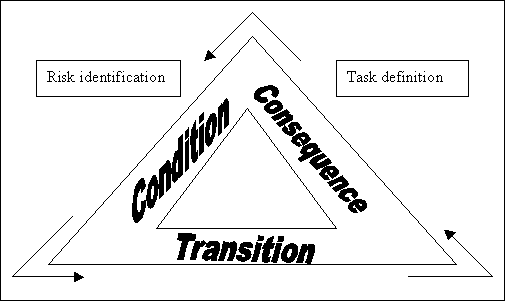

After analyzing Gluch's CTC triangle above, you may ask
"Where are we now?" when identifying a risk. Eventually, you might ask
"What may happen?" and "Where do we want and not want to go?" as the risk
progresses. Using the CTC method will help you break down each risk into
more manageable ones. Those risks will be easier to control because you
had already predicted their occurrence. Identifying and breaking down risks
early in the process of product development will have a lesser chance of
later resulting in the possible consequence.
Identifying a risk initially focuses on the conditions that exist and their potential consequences. When a project is in the early stages of development, there may be little information known about the project and it's potential risks. Later in the project, however, it may be possible to further refine the previously determined project risks to add more detail and clarity to them. This helps the developers uncover and isolate underlying risks, allowing them to better analyze them and map out strategies to deal with them, should they come into reality.
CTC is easy to use
At the minimum, all that is required for CTC risk identification is the statement of the current conditions coupled with an expression of concern about the potential consequences.
CTC is adaptable
The CTC format can be used to manage project risks of any kind. Project risks, technical risks and business risks can all be refined using the CTC format.
CTC is reusable
Risks that are identified and refined using the CTC format
can be managed through the life cycle of the project. They may later be
stored in a risk information sheet or a database.
Go back to main page